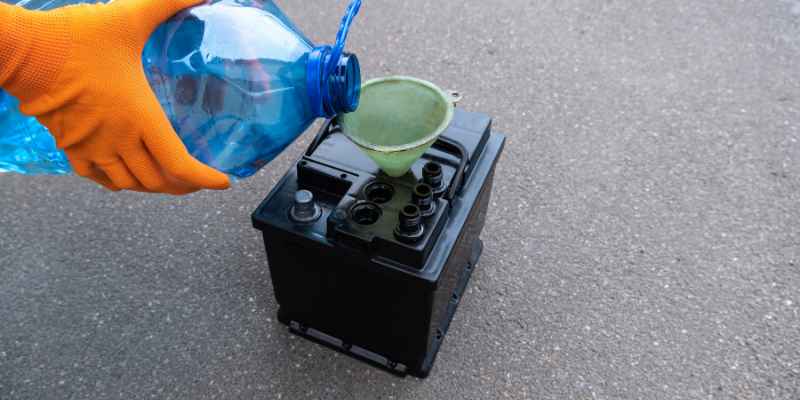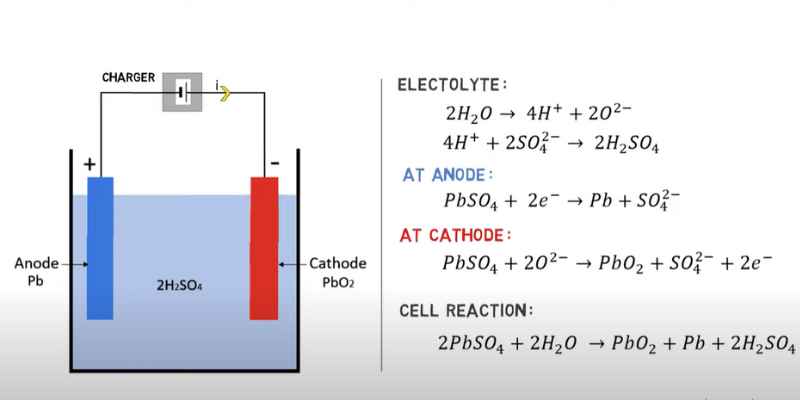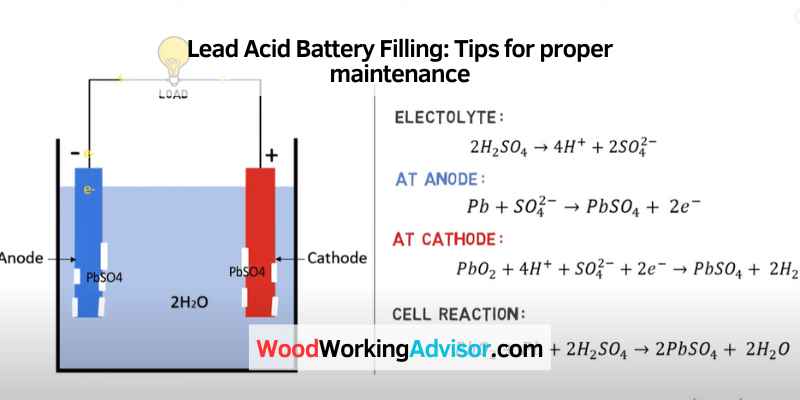Lead acid battery filling involves the process of carefully adding distilled water to the battery cells to maintain optimal electrolyte levels and prevent damage. Lead acid batteries require periodic maintenance, including checking and replenishing the electrolyte levels.
Filling the battery requires the use of distilled water and caution to avoid overfilling, which can cause electrolyte leakage and reduce battery performance. Proper maintenance of lead acid batteries ensures longer battery life and optimal performance. This article provides a guide to lead acid battery filling, discussing the importance of distilled water, the correct filling procedure, and tips for ensuring battery longevity.
Understanding the proper technique for filling lead acid batteries is essential for maximizing their lifespan and ensuring reliable performance.
Importance Of Lead Acid Battery Maintenance
Lead acid battery maintenance is crucial for prolonging battery life and ensuring optimal performance. By properly filling and maintaining lead acid batteries, you can maximize their lifespan and reliability.
Prolonging Battery Life
Regular maintenance routines, such as checking fluid levels and filling them accurately, can significantly extend the life of lead acid batteries.
Ensuring Optimal Performance
Regular inspections and proper topping up of electrolyte levels are essential to maintain the performance of lead acid batteries and avoid premature failure.

Understanding Battery Electrolyte
Battery electrolyte is fundamental to the function of lead-acid batteries. Understanding how to properly fill and maintain the electrolyte is crucial for optimizing battery performance and longevity.
Composition of electrolyte
The electrolyte in a lead acid battery is a crucial component that plays a vital role in its performance. It is a mixture of sulfuric acid (H2SO4) and distilled water. Typically, the concentration of sulfuric acid in the electrolyte is around 35%. The composition of the electrolyte may vary depending on the specific battery design and application.
Role of electrolyte in battery function
The electrolyte in a lead acid battery is responsible for facilitating the chemical reactions that generate electrical energy. It performs several essential functions that ensure the battery operates efficiently:
1. Facilitating ion movement: The primary role of the electrolyte is to allow the movement of ions between the battery’s positive and negative plates. This movement enables the flow of electrical current when the battery is discharging or charging.
2. Maintaining battery capacity: The sulfuric acid concentration in the electrolyte affects the battery’s capacity. The correct concentration ensures optimal performance, allowing the battery to deliver the intended power output and energy storage.
3. Acting as a conductor: Due to the presence of charged ions, the electrolyte acts as a conductor for the electrical current flowing between the battery’s plates. This conduction is crucial for powering various electrical devices and systems.
4. Balancing electrical potential: The electrolyte also helps maintain a balanced electrical potential within the battery. It prevents the buildup of excess charge or potential difference, which can lead to internal short circuits and reduce the battery’s overall lifespan.
Proper maintenance of the electrolyte is essential for ensuring the longevity and optimal performance of lead acid batteries. Regularly checking and maintaining the electrolyte’s specific gravity and acid concentration can help monitor battery health and avoid potential issues.
In conclusion, the electrolyte in a lead acid battery is a critical component that enables the battery to function effectively. Its composition, specifically the concentration of sulfuric acid, plays a significant role in determining the battery’s capacity and overall performance. Understanding the role of electrolyte in battery function is essential for proper maintenance and maximizing the lifespan of lead acid batteries.
Why Proper Filling Is Crucial
Proper filling of lead-acid batteries is crucial to ensure their optimal performance and longevity. Without proper filling, a lead-acid battery can suffer from various issues that can lead to reduced efficiency and a shorter lifespan. In this section, we will discuss why proper filling is crucial, focusing on preventing damage to battery plates, avoiding electrolyte imbalance, and ensuring each H3 heading adheres to HTML syntax.
Preventing Damage To Battery Plates
Proper filling of lead-acid batteries prevents the damage of the battery plates. Overfilling or underfilling can cause the plates to be exposed to air or submerged in electrolyte, leading to corrosion and reduced battery capacity. By following the manufacturer’s guidelines for proper filling, you can prevent damage to the battery plates and ensure consistent performance over time.
Avoiding Electrolyte Imbalance
Proper filling also helps in avoiding electrolyte imbalance. When a battery is underfilled, the electrolyte can become overly concentrated, leading to potential damage. On the other hand, overfilling can dilute the electrolyte, affecting the battery’s performance. Maintaining the correct electrolyte level through proper filling is crucial for the overall health and longevity of the battery.
Tools And Equipment Needed
When it comes to filling lead acid batteries, it is essential to have the right tools and equipment to ensure the process is done safely and effectively. Filling a lead acid battery requires specific items to carry out the task accurately. Let’s take a look at the tools and equipment needed for the lead acid battery filling process.
Safety Gear
- Protective Gloves: Wear chemical-resistant gloves to protect your hands from any potential contact with battery acid.
- Safety Goggles: Goggles protect your eyes from splashes or spills of battery electrolyte.
- Apron or Lab Coat: A protective apron or lab coat can shield your clothing from corrosive substances.
- Face Shield: For an additional layer of protection, a face shield provides coverage for your face and neck.
Filling Tools
- Battery Filling System: A battery filling system with a nozzle attachment for controlled pouring of electrolyte.
- Distilled Water: Ensure you have a supply of distilled water for diluting electrolyte as needed.
- Hydrometer: A hydrometer is used to measure the specific gravity of the electrolyte and determine the state of charge of the battery.
- Battery Filler Tube: A battery filler tube assists in refilling each cell of the battery with precision and accuracy.
Step-by-step Filling Process
Properly filling lead acid batteries is essential for optimal performance and longevity. By following a step-by-step filling process, you can ensure that each battery cell is filled accurately, minimising the risk of overfilling or underfilling. In this article, we will guide you through each stage of the filling process to help you achieve the best results.
Preparation Steps
Before you begin the filling process, it’s important to gather all the necessary tools and materials. Here are the preparation steps to follow:
- Make sure you have a clean and well-lit workspace to work on.
- Wear protective gloves and safety goggles to protect yourself from any potential acid spills.
- Inspect the battery for any damage or leakage. If you notice any issues, do not proceed with the filling process and consult a professional.
- Ensure the battery is in a stable position and cannot tip over during the filling process.
- Prepare distilled water to be used for filling the battery. Tap water contains impurities that could negatively affect the battery’s performance.
Filling The Battery Cells
Now that you have completed the preparation steps, you can proceed with filling the battery cells. Follow these guidelines:
| Step | Description |
|---|---|
| Step 1 | Remove the battery cell caps using a suitable tool. Make sure to place the caps in a clean and safe location. |
| Step 2 | Inspect each battery cell and check the electrolyte levels. The electrolyte should be around 1/8″ to 1/4″ below the bottom of the vent cap. |
| Step 3 | Carefully pour distilled water into each battery cell using a funnel. Be cautious not to overfill, as it can cause acid spills and damage the battery. |
| Step 4 | Allow the battery to sit for a few minutes to let the water settle. You can gently tap the sides of the battery to dislodge any air bubbles. |
| Step 5 | Reinstall the battery cell caps tightly, ensuring a secure seal to prevent leakage. |
By following these step-by-step instructions, you can fill your lead acid battery correctly and maintain its optimal performance. Remember to always prioritize safety, and consult a professional if you are unsure about any aspect of the process.
Signs Of Overfilling Or Underfilling
Proper lead acid battery filling is crucial to avoid overfilling or underfilling, which can lead to potential damage or reduced performance. Signs of overfilling include electrolyte leakage, while underfilling may result in poor battery efficiency and shorter lifespan. Regular monitoring and maintenance are key to optimal battery function.
Effects On Battery Performance
Overfilling or underfilling lead-acid batteries can have detrimental effects on their performance.
- Overfilling can cause electrolyte spillage, leading to corrosion and reduced battery life.
- Underfilling can result in plate exposure, sulfuric acid concentration imbalance, and decreased capacity.
How To Rectify Overfilling/underfilling
To address overfilling or underfilling issues, follow these steps:
- Check the electrolyte level using a proper measuring tool.
- If overfilled, carefully remove excess electrolyte to the correct level.
- If underfilled, add distilled water to reach the optimal level.
- Ensure proper ventilation to prevent overcharging and electrolyte loss.
Signs of overfilling or underfilling a lead-acid battery include poor performance, electrolyte leakage, and decreased capacity.
Overfilling can lead to corrosion, while underfilling may expose the plates, affecting battery efficiency.

Tips For Safe Handling
When dealing with lead-acid battery filling, it is crucial to follow safety precautions to avoid accidents. Below are some essential tips to ensure safe handling of lead-acid batteries.
Avoiding Spills
- Always fill the battery cells slowly to prevent spills.
- Use a funnel to pour electrolyte into the cells accurately.
- Be careful not to overfill the battery cells to prevent acid spills.
Proper Disposal Of Old Electrolyte
- Never dispose of old electrolyte in regular trash or down a drain.
- Follow local regulations for safe disposal of old electrolyte.
- Wear protective gear, such as gloves and goggles, when handling old electrolyte.
Frequency Of Checking And Refilling
Lead acid battery filling is a crucial aspect of maintaining the performance and longevity of the battery. Understanding the frequency of checking and refilling helps in ensuring that the battery functions optimally and delivers consistent power. Let’s delve into the periodic maintenance schedule and indications that it’s time for a refill.
Periodic Maintenance Schedule
It is essential to adhere to a periodic maintenance schedule for lead acid battery filling to prevent any performance issues. Proper scheduling ensures that the electrolyte levels are always within the recommended range, preventing damage to the battery’s lead plates. Here’s a general guide for maintenance:
| Frequency | Action |
|---|---|
| Monthly | Check the electrolyte levels and top up if necessary |
| Quarterly | Inspect the battery for any signs of leakage or damage |
| Annually | Perform a comprehensive battery inspection and maintenance |
Indications That It’s Time For A Refill
Regularly monitoring the battery’s condition helps in identifying when it’s time for a refill. Some common indications include:
- Visible decrease in electrolyte levels through the transparent casing
- Reduced battery performance or inability to hold a charge for as long as usual
- Corrosion or sulfation on the battery terminals, indicating electrolyte depletion
- Alarming signs of excessive heat or off-gassing, which may signify low electrolyte levels
Frequently Asked Questions Of Lead Acid Battery Filling
What Is A Lead Acid Battery?
A lead acid battery is a rechargeable energy storage device commonly used in vehicles and backup power systems. It consists of lead dioxide and sponge lead electrodes immersed in a sulfuric acid solution.
How Often Should Lead Acid Battery Be Filled?
Lead acid batteries should be checked regularly and topped up with distilled water as needed, typically every 1-2 months. Overfilling should be avoided to prevent spillage, and the water level should be maintained just above the plates.
Why Is It Important To Fill Lead Acid Batteries Properly?
Proper filling of lead acid batteries ensures optimal performance and longevity. Maintaining the correct electrolyte levels allows for efficient chemical reactions within the battery, preventing damage to the plates and preserving its overall functionality.
Conclusion
In a nutshell, lead acid battery filling is a crucial process that ensures the optimal performance and longevity of your batteries. By following the correct procedures and using the right tools, you can efficiently fill your batteries and prevent any potential issues.
Regular maintenance and proper filling techniques will not only maximize your battery’s lifespan but also improve its overall efficiency. So, make sure to prioritize the filling process and keep your batteries in top-notch condition for years to come.


